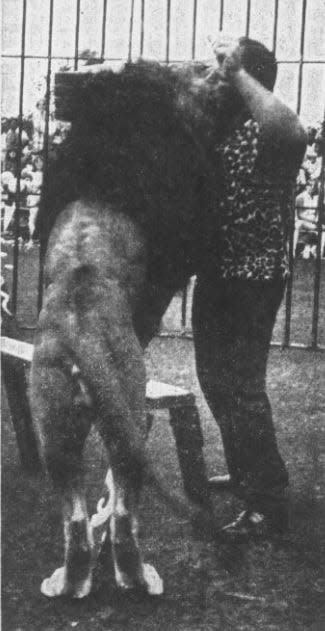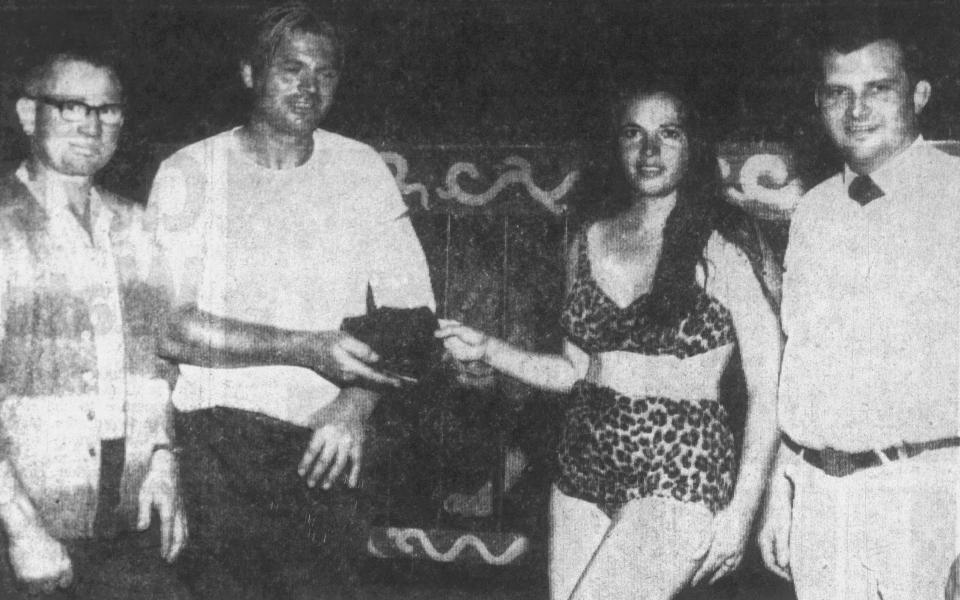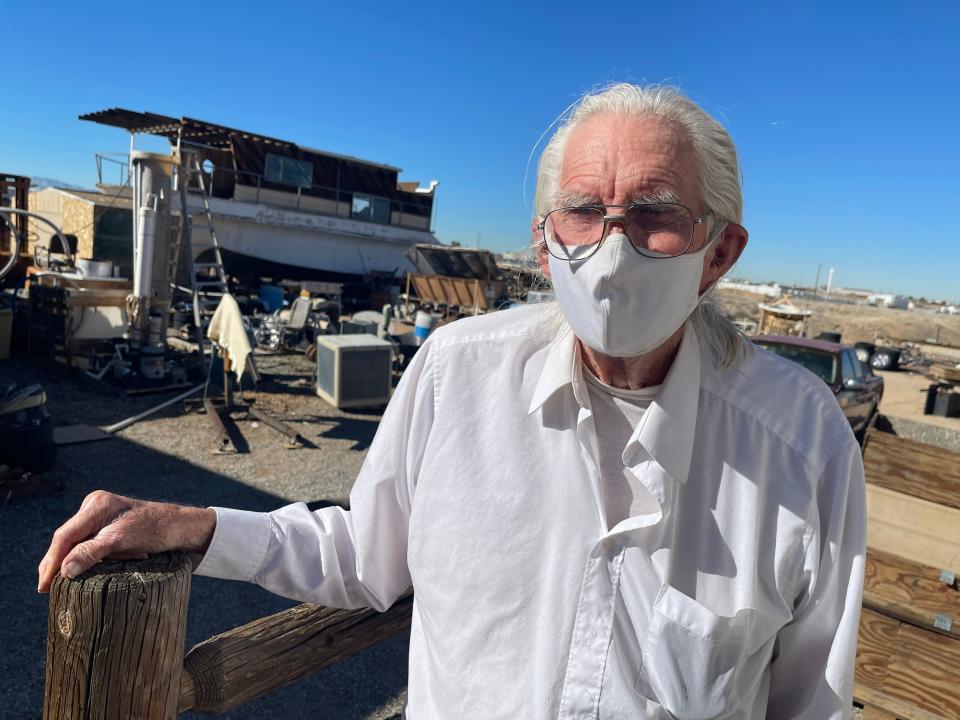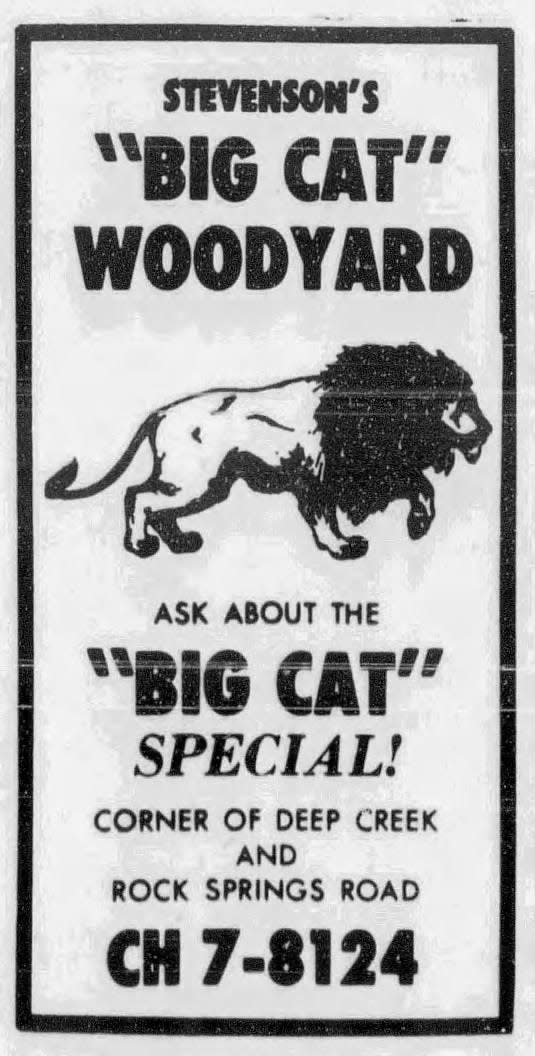Did you hear about the African lions that ate their owners in Apple Valley?
- Oops!Something went wrong.Please try again later.

The story of lion owners Rolland and Sheila Stevenson was written mainly to dispel decades of rumors that swirled around the couple's two African lions, who lived in Apple Valley in the early ‘60s.
One rumor was that the “aging couple with dementia” forgot to feed lions, “Numo” and “Tyki.” During a moment of clarity, the couple entered the cage with food and were eaten alive by the big cats.
Another rumor was that the lions escaped their pens and went on a human and animal killing spree in rural Apple Valley. That ended when a group of armed citizens hunted the lions and shot them dead.
None of the rumors came close to what happened to the couple and also their pet lions, who were eventually destroyed after several attacks.
Rolland and Sheila Stevenson
In 1953, immediately after graduating from Kramer High School in Columbus, Nebraska, Rolland Stevenson enlisted in the Navy and served aboard the USS Canberra until he retired in 1957. When he returned stateside at age 25, Stevenson began working as a lumberjack and tamer of big cats for the circus.
In 1960, Stevenson moved to California, where he met Sheila Kathleen Moore, 21, at the Arthur Murray Dance Studio in Hollywood. Sheila taught dance lessons.
During Sheila's childhood, her family moved frequently between California and Mexico, and at one point owned a mining business in Mexico. While helping operate the various family businesses over the years, Sheila also trained dogs, played acoustic guitar and enjoyed singing and playing in a local band.
After the two married on Sept. 2, 1960 at the Little Country Church in Hollywood, the Stevensons settled down in a quiet neighborhood in Inglewood, a growing city with less than 70,000 residents in Los Angeles County.

Hungry lions, scared neighbors
With experience in raising and training animals, the Stevesons traveled to the Thousand Oaks Jungleland theme park, where they purchased two black-maned African lion cubs — “Numo,” named after Tarzan’s pet, and the lion’s half brother, “Tyki.”
Everything was peaceful around the Stevenson’s neighborhood until residents and law enforcement officials became concerned when 5-month-old Tyki got bigger and more aggressive and 11-month-old Numo started roaring and devouring seven pounds of meat per day, the San Bernardino County Sun reported.
Police deputy Ed Branson visited the Stevenson's home after the lions reportedly scared neighbors, made meter readers “scream like banshees” and frightened mail carriers.
“Yes, we’ve got a lion. Two of them,” sighed Mrs. Stevenson, as she looked at Branson while Tyki played at her feet. “The older one is in his pen out back.”
As the Inglewood City Council began discussing a proposed animal ordinance to possibly oust the lions, the Stevensons decided it was time to move.

African lions in Apple Valley
In 1961, the Stevensons settled in Apple Valley, a quiet desert abode with less than 9,000 people, no prying neighbors and plenty of outdoor space.
The couple purchased a home and 10 acres of land near the southwest corner of Deep Creek and Rock Springs roads, Hesperia resident William “Peter” Peterson told the Daily Press.
The Stevensons also built two, 100-foot round chain link fence pens, where Rolland would train Numo and Tyki.
Rolland would take Numo to perform at carnivals, fairs, nightclubs and other sites. He also waited for Tyki to reach training age before he would let the young lion perform, according to Peterson.
Both lions slept in the couple’s garage and took walks on leashes where the young cats would tumble and learn to stalk and leap on their prey.
In 1962, the lions were regular visitors at the San Bernardino County Library’s Bookmobile when it stopped in Hesperia, Petersons said.

Close encounters with the kings of the jungle
The Stevensons obtained a library card for “Numo,” who checked out books with titles such as “Tracking the Big Cats,” “The Sleepy Lion,” “My Life with the Big Cats” and “The Happy Lion," The San Bernardino County Sun reported.
During a holiday kiddie show in December 1962, at the now-shuttered George Air Force Base, a frightened “Numo the Dandy Lion” froze in front of the audience, The Sun reported.
A shocked Rolland watched as the big cat began growling at the 900 cheering children and 250 parents who gathered for the event at the Desert Crossroads Recreation Center.
“The poor cat appeared scared to death” according to Staff Sgt. Dean Schultz, who oversaw the center.
"It was at that time that Rolland first feared Numo," Peterson said. "He feared him, but that didn't stop him from taking him out to perform."
Showing lions, selling firewood
The couple would sell firewood by advertising Stevenson’s “Big Cat” Woodyard located on the corner of Deep Creek and Rock Springs roads in Apple Valley.
A typical Daily Press newspaper ad would read, “Ask about the Big Cat special,” with firewood for $31.50 per cord, plus tax and free delivery. Call CH 7-8124 and remember, “We’re on a party line.”
In 1963, Numo weighed 350 pounds with Tyki topping the scale at nearly 150 pounds. Rolland said his two affectionate “giant pets are really as gentle as kittens.”
A man of faith, Rolland also created a “rugged cross” of pinon pine to be the center of an Ascension Lutheran Church Easter sunrise service at Sycamore Rocks in Apple Valley, the Daily Press reported.
Paul Johnson, of Hinkley, told the Daily Press that residents from all over the High Desert would stop by Stevenson’s property to catch a glimpse of the big cats.
“Stevenson sold wood and showed off his lions at that corner, and one of his neighbors even had a chinchilla ranch,” Johnson said. “That corner was quite the attraction.”
Tyki draws blood
After 1963, Tyki is not mentioned in any news publication and three years later, the last ad for Stevenson’s “Big Cat” Woodyard appeared in the Daily Press.
Johnson told the Daily Press that a friend and business partner of Rolland shot and killed Tyki after he attacked the owner.
“One day, the lion turned on Rolland and mauled him a bit, but it wasn’t too bad,” said Johnson, who was born on the Johnson Turkey Ranch on Deep Creek Road. “The lion became increasingly aggressive after that and he was afraid to bring it out for shows.”
In 2022, William Peterson, 86, told the Daily Press that he was the man who shot and killed Tyki after the lion attacked Rolland, “drew blood and went crazy.”
“Rolland came pounding on my door early in the morning and wondered if I would come down and shoot the lion,” Peterson told the Daily Press. “The lions were kept in a portable cage with a plywood roof and Rolland was afraid that Tyki might get out into the neighborhood."
After the lion was killed, Peterson was given Tyki’s head and pelt with plans to have the animal taxidermied.
“I had it in a box in a barn in Victorville and somebody stole it,” Peterson said. “I had it for quite a while.”
Nebraska bound, Numo attacks
In 1966, the Stevensons moved to the Columbus, Nebraska area where Rolland continued to have the nearly 600-pound Numo perform at schools, carnivals, and fairs via the Gem International Circus, The Alliance Daily Times-Herald reported.
During a circus act in July 1966, a shocked crowd watched as Numo clawed Rolland’s back and sank his sharp fangs into his left arm, The Time Herald reported.
According to Rolland’s wife, who assisted during performances, a flash of light at the high school stadium scared Numo, who reverted to his jungle instincts.
Numo released Rolland after Sheila called Numo and waved a hoop at him.
A doctor used 18 stitches to patch up Rolland’s arm. He would spend the afternoon hospitalized, before returning to perform with Numo.
Rolland explained that “once a cat turns on his trainer” extreme caution must be exercised.
Later that month, Numo attacked Rolland’s father, Charles Stevenson, 61. The big cat nearly tore the man's arm off, The Times Herald reported.
The incident began when a light rain started falling on the family farm and Charles Stevenson and his daughter-in-law, Sheila, went to cover Numo’s cage. As the two began covering the cage, Numo quickly reached out and clawed the arm of Charles Stevenson.
Sheila took a wooden 2-by-4 and beat Numo, who eventually released her father-in-law.
‘Grumpy Numo’ sent to zoo
In August 1966, a “grumpy” Numo retired from show business.
“I feel we cannot continue the act with the fear that my wife or I might be seriously injured or —possibly—killed,” Rolland told the Time Herald. “As far as I’m concerned, and I don’t think I’ll change my mind, we’ll never enter the arena with this animal again."
At the time, Numo was one of the few male African black-maned lions in captivity, according to Rolland.
Peterson said Rolland told him that Numo was eventually put down by zoo officials.
“Lions are wild animals and can only be domesticated so much before instinct takes over,” Peterson said. “They were beautiful animals, and Rolland and Sheila were wonderful people."
With the lions gone, the Stevensons moved to Columbus, Nebraska, then later Richland, where they established and operated Nebraskaland Kennels for over 15 years.
Daily Press reporter Rene Ray De La Cruz may be reached at 760-951-6227 or RDeLaCruz@VVDailyPress.com. Follow him on Twitter @DP_ReneDeLaCruz
This article originally appeared on Victorville Daily Press: Did you hear about the lions from Apple Valley that ate their owners?

